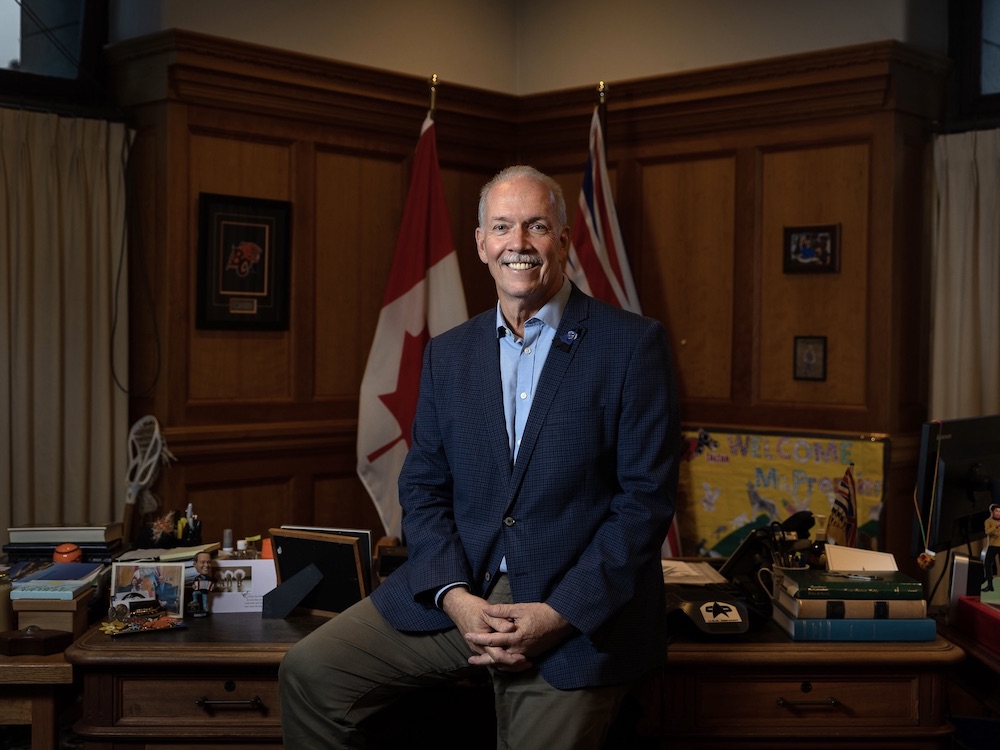The swearing in of David Eby as B.C. premier this morning also marks the end of John Horgan’s time in the job.
Horgan was premier for five-and-a-half years, but since June when he announced his resignation after throat cancer treatment he has been engaged in a long goodbye during which he has generally been reluctant to talk about what he thinks his legacy is and what the government he led will be remembered for.
In contrast, in a September speech to the Union of BC Municipalities convention in Whistler, he mentioned a few achievements of the Dave Barrett NDP’s three years in government in the 1970s. They included founding the resort municipality of Whistler, purchasing Ocean Falls and banning the strap from classrooms.
He might also have cited the creation of the Agricultural Land Reserve, the start of government-owned auto insurance, pharmacare, the human rights code, the BC Human Rights Commission, the provincial ambulance service, expanded provincial parks, BC Day and many other legacies of Barrett’s brief government.
Following the speech, The Tyee asked Horgan what he thought his own government would be remembered for. “I'm a historian,” he said, “but I'm not going to do history from the podium.... Maybe we'll have a chance to talk about that at another time.”
He did say he hopes that “people would speak well of our efforts to try and solve what have been extraordinary circumstances, events.”
The government was elected in 2017 and again, with a majority, in 2020 with a platform. But it found itself responding to the COVID-19 pandemic that has killed at least 4,550 people in the province and required the government to step in to help as large sections of the economy closed to prevent the spread of the virus.
Then there was the heat dome that killed 619 people, the burning of the town of Lytton and an atmospheric river that overwhelmed dikes in the Fraser Valley and buried or washed out sections of several highways.
“These are things that are brand new to all of us that had horrific impacts on people and communities,” said Horgan. “I'm hopeful that they will say we did our best under trying circumstances.”
While Horgan’s government may not have had the activist bent that Barrett’s did, generally taking a more pragmatic or incremental path, it did make some big decisions. Some were controversial and remain so, and some will widely be looked back on as accomplishments.
Here are eight:
1. Getting big money out of politics
Among the first moves under Horgan’s leadership was to end the “wild west” of political fundraising in the province. The new rules banned donations from corporations and unions and capped contributions from individuals at $1,200 a year. The then minority government, supported by Green MLAs, made the change despite the NDP having significantly out-fundraised its opponents in the 2017 election year.
“I have no regrets,” Horgan later said. “The right thing to do was to get big money out of politics.” The bill also introduced per vote subsidies funded through provincial revenues, an arrangement all of the parties have quietly gotten used to.
2. Continuing the construction of the Site C dam
At the end of 2017 the Horgan government made one of its most controversial decisions when it approved the continued construction of the Site C dam on the Peace River despite opposition in court from some First Nations and the flooding of large stretches of agricultural land. It was with “heavy hearts” that cabinet gave the go-ahead to a project that Horgan and others in his party had campaigned against and stressed they never would have started.
Still, with $4 billion already sunk in the project the financial impact of cancelling what was then expected to be a $10.7-billion project would have been significant, Horgan argued. A little more than three years later the projected budget had risen to $16 billion, but still Horgan’s government decided to press on. One day, maybe, the large publicly owned project will provide the province with relatively clean low-emission hydro power. What it ultimately costs remains to be seen.
3. Building LNG Canada
By the time the NDP came to office, the LNG Canada liquification and export terminal now under construction in Kitimat had been approved and permitted. But the Shell-led consortium that owned the $40-billion project didn’t make a final decision to move ahead until after Horgan’s government helped out with a raft of incentives that included eliminating the LNG income tax, offering a reduced price for electricity from BC Hydro, rebating new carbon taxes and exempting construction materials from provincial sales tax.
The success was a poke at BC Liberal opponents who had labelled the NDP the “party of no” but had themselves failed to get any terminals over the finish line despite promises regarding dozens of proposals and enough revenue to make the province debt-free. It will also add substantially to B.C.’s greenhouse gas emissions.
4. Agreeing to CleanBC with the BC Green Party caucus
In 2018, a week after the announcement the LNG Canada project would proceed, Horgan was front and centre to release the CleanBC plan to reduce the province’s greenhouse gas emissions. He was joined by then Green Party leader Andrew Weaver, a climate scientist who had been a critic of the province’s LNG dreams but who endorsed CleanBC.
The province, which was on track to miss its previous goal of a 33-per-cent reduction in carbon emissions from 2007 levels, set new goals of a 60-per-cent reduction by 2040 and 80 per cent by 2050. In the short term the plan, later added to, gave the government a defence against critics of oil and gas expansion, allowing Horgan and others to say it’s OK as long as it fits in the plan — which the Greens had endorsed.
And who will we hold accountable if the targets are missed in 2050? “The government of the day,” Horgan said back then. “These are legislated targets and until they’re changed, governments are responsible to meet them.... It’s the international community that is setting targets out to 2050.... If it’s aspirational for everyone else, it’s aspirational for us as well.”
5. Commissioning a strategy for old-growth forests
Under Horgan’s leadership the NDP government commissioned a substantial report on the future of old-growth forests in the province and promised to act on it. The 14 recommendations in A New Future For Old Forests would totally overhaul the management of old-growth forests, starting with grounding the system in a government-to-government framework involving both provincial and Indigenous governments.
It would also “prioritize ecosystem health and resilience” so that the health of forests comes first and shift from seeing forests primarily through a financial lens where ecosystem health is viewed as a “constraint.” Since then there have been disputes over whether the government has actually protected any old-growth forests that would have been logged and critics have said there hasn’t been enough evidence of progress towards making the strategy reality.
6. Beginning to make BC’s laws consistent with UNDRIP
In 2019 the B.C. government introduced legislation that would make the province the first to recognize the 46 articles of the United Nations declaration in provincial laws. While it was enabling legislation and Indigenous leaders warned it would take many years of hard work to complete the job, it was widely hailed as an important step forward.
Grand Chief Stewart Phillip, the president of the Union of BC Indian Chiefs, this week said in a statement that the advance required Horgan’s leadership. “We are grateful to Premier Horgan for working with us, instead of against us, on this monumental and historic piece of legislation for Indigenous rights, and for providing us with a framework that will be essential in holding future governments accountable to our rights as Indigenous peoples.”
7. Introducing a fee for FOI requests
While in opposition, Horgan and the NDP were great users of the Freedom of Information and Protection of Privacy Act and supported making it stronger to help people seeking records from public bodies. But after forming government Horgan appeared to lose interest in improving the FOI law and last year passed legislation that has allowed government ministries and others covered by the act to begin charging $10 to file requests.
The new charge is on top of the sometimes large fees public bodies could already charge and the move was widely criticized by Information and Privacy Commissioner Michael McEvoy, civil society groups, reporters and academics. Nor has the government followed through on extending coverage of FIPPA to the legislature itself, something it considered following the spending scandal that saw former clerk Craig James lose his job and be found guilty in criminal court of fraud and breach of trust.
8. Making life more affordable?
The word “affordability” and its variations appeared 51 times in the NDP’s 2020 re-election platform and it was a theme in the 2017 campaign as well. With prices rising rapidly and the living wage higher than ever, individuals will have to decide whether they and their family are better off than they were five years ago, but the government did take various steps.
These include phasing out Medical Services Plan premiums, which were much less progressive than income taxes where people making more money pay proportionally more tax, and replacing them with the Employer Health Tax. There were changes to ICBC policies that got the Crown corporation’s finances back in order and saw rebates sent to drivers, despite complaints from lawyers and others.
For families, the number of child care spaces has grown and they’ve been made cheaper. The province capped rent increases at the rate of inflation instead of keeping the formula in place since 2004 that had allowed rents to grow far faster, but a long-promised $400 annual rebate for renters is yet to materialize.
And then there was the speculation and vacancy tax that applied to empty homes and is believed to have brought some 20,000 homes into the rental market between 2018 and 2020. While the cost of housing continues to rise anyway, supporters of the government argue that without measures the province took the cost would be even higher.
The day Horgan announced he was stepping down, he acknowledged that whatever the government had done in the past five-and-a-half years under his leadership it still had plenty of work to do on key issues.
Aside from affordability and the effects of high inflation, his list included crime, homelessness, the health-care crisis and the opioid poisoning emergency, all of which critics have argued have gotten worse on Horgan’s watch.
With Eby stepping into the premier’s office today and set to name his cabinet Dec. 7, now it will be someone else’s turn to try. ![]()
Read more: BC Politics
















Tyee Commenting Guidelines
Comments that violate guidelines risk being deleted, and violations may result in a temporary or permanent user ban. Maintain the spirit of good conversation to stay in the discussion.
*Please note The Tyee is not a forum for spreading misinformation about COVID-19, denying its existence or minimizing its risk to public health.
Do:
Do not: